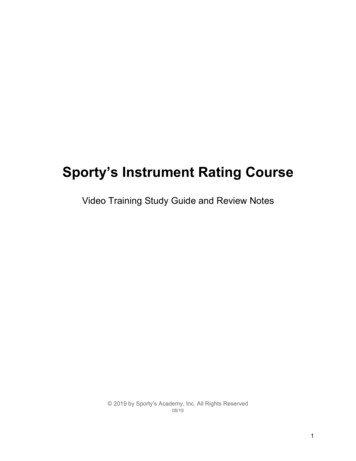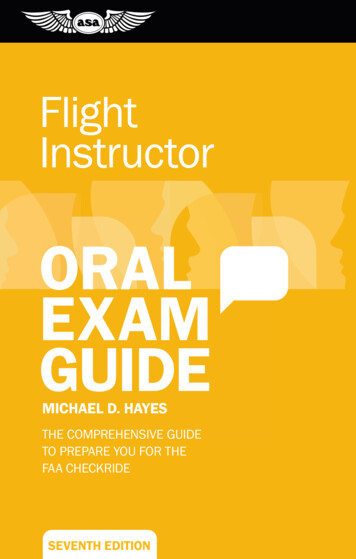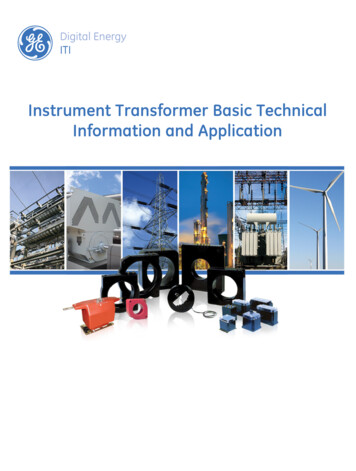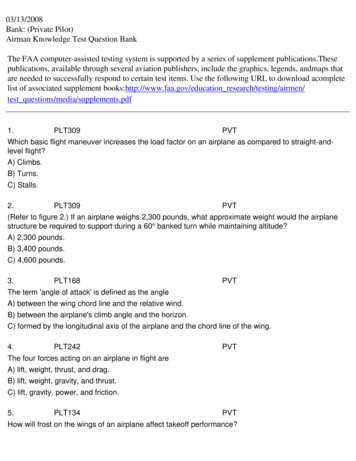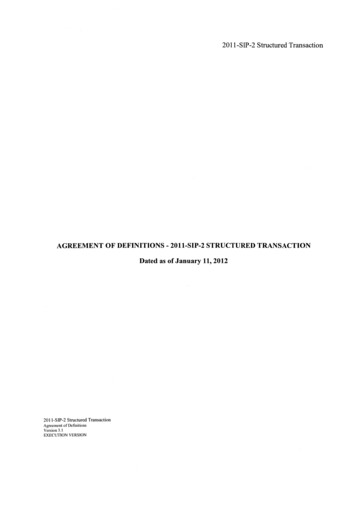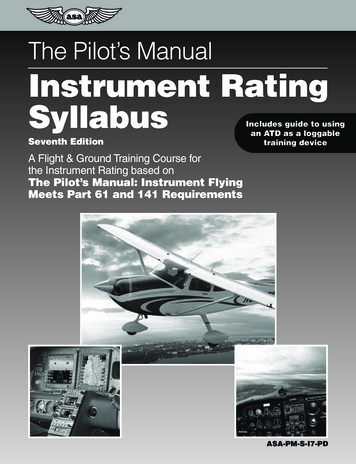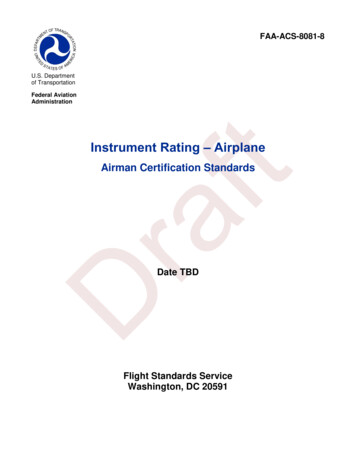
Transcription
FAA-ACS-8081-8U.S. Departmentof TransportationFederal AviationAdministrationInstrument Rating ‒ AirplaneraftAirman Certification StandardsDDate TBDFlight Standards ServiceWashington, DC 20591
AcknowledgmentsThe U.S. Department of Transportation, Federal Aviation Administration (FAA), Airman Testing StandardsBranch, AFS-630, and P.O. Box 25082, Oklahoma City, OK 73125 developed this Airman Certification Standards(ACS) document with the assistance of the aviation community. The FAA gratefully acknowledges the valuablesupport from the many individuals and organizations who contributed their time and expertise to assist in thisendeavor.AvailabilityThis ACS is available for download from www.faa.gov. Please send comments regarding this document toAFS630comments@faa.gov.DraftMaterial in FAA-S-8081-ACS-IRA-1 will be effective June 2016. All previous editions of the Instrument Rating –Airplane, Helicopter, and Powered Lift Practical Test Standards will be obsolete as of this date for Airplaneapplicants. Helicopter and Powered Lift applicants should continue to use the FAA-S-8081-4E.ii
ForewordThe Federal Aviation Administration (FAA) has published the Instrument Rating Airplane Airman CertificationStandards (ACS) document to communicate the aeronautical knowledge, risk management, and flight proficiencystandards for the instrument rating (IR) in the airplane category, single-engine land and sea; and multiengine landand sea classes. This ACS incorporates and supersedes the previous Practical Test Standards (PTS), FAA-S8081-4, for Instrument Rating Airplane applicants.The FAA views the ACS as the foundation of its transition to a more integrated and systematic approach toairman certification. The ACS is part of the safety management system (SMS) framework that the FAA uses tomitigate risks associated with airman certification training and testing. Specifically, the ACS, associated guidance,and test question components of the airman certification system are constructed around the four functionalcomponents of an SMS:Safety Policy that defines and describes aeronautical knowledge, flight proficiency, and risk managementas integrated components of the airman certification system; Safety Risk Management processes through which internal and external stakeholders identify and evaluateregulatory changes, safety recommendations, and other factors that require modification of airman testingand training materials; Safety Assurance processes to ensure the prompt and appropriate incorporation of changes arising fromnew regulations and safety recommendations; and Safety Promotion in the form of ongoing engagement with both external stakeholders (e.g., the aviationtraining industry) and FAA policy divisions.raft The FAA has developed this ACS and its associated guidance in collaboration with a diverse group of aviationtraining experts. The goal is to drive a systematic approach to all components of the airman certification system,including knowledge test question development and conduct of the practical test. The FAA acknowledges andappreciates the many hours that these aviation experts have contributed toward this goal. This level ofcollaboration, a hallmark of a robust safety culture, strengthens and enhances aviation safety at every level of theairman certification system.DJohn S. DuncanDirector, Flight Standards Serviceiii
Revision HistoryRev. #FAA-S-80814E, Chg 5Effective DateInstrument Rating for Airplane, Practical TestStandards with Changes 1-5January 2010Instrument Rating Airplane, Airman CertificationStandardsJune 15, 2016DraftIDescriptioniv
Table of ContentsIntroduction . 1Airman Certification Standards Concept . 1Using the ACS. 1I.Preflight Preparation . 3Task A. Pilot Qualifications. 3Task B. Weather Information. 4Task C. Cross-Country Flight Planning . 5II. Preflight Procedures . 6Task A. Aircraft Systems Related to IFR Operations . 6Task B. Aircraft Flight Instruments and Navigation Equipment . 7Task C. Instrument and Equipment Cockpit Check . 8III. Air Traffic Control Clearances and Procedures . 9tTask A. Compliance with Air Traffic Control Clearances . 9Task B. Holding Procedures. 10rafIV. Flight by Reference to Instruments . 11Task A. Instrument Flight . 11Task B. Recovery from Unusual Flight Attitudes . 12V. Navigation Systems . 13Task A. Intercepting and Tracking Navigational Systems and DME ARCS. 13Task B. Departure, En route and Arrival Operations. 14VI. Instrument Approach Procedures . 15Task A. Nonprecision Approach . 15Task B. Precision Approach . 16Task C. Missed Approach . 18DTask D. Circling Approach . 19Task E. Landing from an Instrument Approach. 20VII. Emergency Operations . 21Task A. Loss of Communications . 21Task B. One engine inoperative during straight-and-level flight and turns (Multiengine Airplane) . 22Task C. One Engine Inoperative – Instrument Approach (AMEL, AMES) . 23Task D. Approach with Loss of Primary Flight Instrument Indicators . 24VIII. Postflight Procedures . 25Task A. Checking Instruments and Equipment . 25Appendix Table of Contents . 27v
DraftThis page intentionally left blank.vi
IntroductionAirman Certification Standards ConceptThe goal of the airman certification process is to ensure the applicant possesses knowledge and skill consistentwith the privileges of the certificate or rating being exercised, as well as the ability to manage the risks of flight aspilot in command.In fulfilling its responsibilities for the airman certification process, the Federal Aviation Administration (FAA) FlightStandards Service (AFS) plans, develops, and maintains materials related to airman certification training andtesting. These materials include several components. The FAA knowledge test measures mastery of theaeronautical knowledge areas listed in Title 14 of the Code of Federal Regulations (14 CFR) part 61. Othermaterials, such as handbooks in the FAA H-8083 series, provide guidance to applicants on aeronauticalknowledge, risk management, and flight proficiency.The FAA recognizes that safe operation in today's complex National Airspace System (NAS) require a moresystematic integration of aeronautical knowledge, risk management, and flight proficiency standards than thoseprescribed in the PTS. The FAA further recognizes the need to more clearly calibrate the standards forknowledge, risk management, and skill to the level of the certificate or rating.raftTo accomplish this goal, the FAA drew upon the expertise of organizations and individuals across the aviation andtraining community to develop the Airman Certification Standards (ACS). The ACS integrates the elements ofknowledge, risk management, and skill listed in 14 CFR part 61 for each airman certificate or rating. It thus formsa more comprehensive standard for what an applicant must know, consider, and do for the safe conduct andsuccessful completion of each Task to be tested on either the knowledge exam or the practical test.The ACS improves the Knowledge test part of the certification process by enabling the development of testquestions that are meaningful and relevant to safe operation in the NAS. The ACS does not change any of theperformance metrics for any skill task, and it is important for applicants, instructors, and evaluators to understandthat the addition of knowledge and risk management elements is not intended to lengthen or expand the scope ofthe practical test. Rather, the integration of knowledge and risk management elements associated with each Taskis intended to enable a more holistic approach to learning, training, and testing. During the oral portion of thepractical test, for example, the ACS provides greater context and structure both for retesting items missed on theknowledge test and for sampling the applicant’s mastery of knowledge and risk management elements associatedwith a given skill task.DThrough the oral and flight portions of the practical test, the FAA expects evaluators to assess the applicant'smastery of the topic in accordance with the level of learning most appropriate for the specified Task. For sometopics, the evaluator will ask the applicant to describe or explain. For other items, the evaluator will assess theapplicant's understanding by providing a scenario that requires the applicant to appropriately apply and/orcorrelate knowledge, experience, and information to the circumstances of the given scenario. The flight portion ofthe practical test requires the applicant to demonstrate knowledge, risk management, flight proficiency, andoperational skill in accordance with the ACS.Note:As used in the ACS, an evaluator is any person authorized to conduct airman testing (e.g., an FAAaviation safety inspector, designated pilot examiner, or other individual authorized to conduct a test for acertificate or rating.)Using the ACSThe ACS consists of Areas of Operation arranged in a logical sequence, beginning with Preflight Preparationand ending with Postflight Procedures. Each Area of Operation includes Tasks appropriate to that Area ofOperation. Each Task begins with an Objective stating what the applicant should know, consider, and/or do. TheACS then lists the aeronautical knowledge, risk management, and skill elements relevant to the specific Task,along with the conditions and standards for acceptable performance. The ACS uses Notes to emphasize specialconsiderations. The ACS uses the terms "will" and "must" to convey directive (mandatory) information. The ACSuses the terms "will" and "must" as mandatory. The term “may” denotes items that are recommended but notrequired. The References for each Task indicate the source material for Task elements. For example, in Tasks1
such as “Current and forecast weather for departure, arrival, and enroute” (IR.I.B.K1), the applicant must beprepared for questions on any weather product presented in the references for that Task.The abbreviation(s) within parentheses immediately following a Task refer to the category and/or class aircraftappropriate to that Task. The meaning of each abbreviation is as follows.ASEL:ASES:AMEL:AMES:Note:Airplane – Single-Engine LandAirplane – Single-Engine SeaAirplane – Multiengine LandAirplane – Multiengine SeaWhen administering a test based on this ACS, the Tasks appropriate to the class airplane (ASEL, ASES,AMEL, or AMES) used for the test must be included in the plan of action. The absence of a classindicates the Task is for all classes.Each Task in the ACS is coded according to a scheme that includes four elements. For example:IR.VIII.A.K1: Applicable ACS (Instrument Rating ‒ Airplane)Area of Operation (Postflight Procedures)Task (Checking instruments and equipment)Knowledge Task element 1 (the requirements for documenting equipment malfunctions)tIRVIIIAK1rafKnowledge test questions are mapped to the ACS codes, which will soon replace the system of “LearningStatement Codes.” After this transition occurs, the airman knowledge test report will list an ACS code thatcorrelates to a specific Task Element for a given Area of Operation and Task. Remedial instruction and re-testingwill be specific, targeted, and based on specified learning criteria. Similarly, a Notice of Disapproval for thepractical test will use the ACS codes to identify the deficient Task element(s).The applicant must pass the Instrument Rating Airplane knowledge test before taking the practical test. Thepractical test is conducted in accordance with the ACS that is current as of the date of the test. Further, theapplicant must pass the oral portion of the practical test before beginning the flight portion. The oral portion of thepractical test allows the evaluator to determine whether the applicant is sufficiently prepared to advance to theflight portion of the practical test. The evaluator must assess the applicant on all Skill elements for each Taskincluded in each Area of Operation of the ACS unless otherwise noted. The evaluator must also assess at leastone Knowledge element and one Risk Management element in each Area of Operation and Task. Additionally,the evaluator must include each task element(s) the applicant missed on the knowledge test. The evaluatoradministering the practical test has the discretion to combine tasks/elements as appropriate to testing scenarios.DThe FAA encourages applicants and instructors to use the ACS to measure progress during training, and as areference to ensure the applicant is adequately prepared for the knowledge and practical tests. The FAA willrevise the ACS as circumstances require.2
I.Preflight PreparationTaskTask A. Pilot QualificationsReferences14 CFR part 61; FAA-H-8083-2, FAA-H-8083-15ObjectiveTo determine the applicant exhibits satisfactory knowledge, risk management, and skillsassociated with the requirements to act as Pilot-in-Command (PIC) under InstrumentFlight Rules (IFR).KnowledgeThe applicant demonstrates understanding of:IR.I.A.K11. When an instrument rating is required.IR.I.A.K22. Recent instrument flight experience requirements.IR.I.A.K33. Meteorological requirements necessary to qualify for logging currency.IR.I.A.K44. Requirements when instrument rating flight experience is not recent.IR.I.A.K55. Pilot logbook/record-keeping.Skills6. Physiological factors that might affect the pilot’s ability to fly under instrument conditions.tThe applicant demonstrates the ability to identify, assess and mitigate risks, encompassing:1. Maintaining currency versus proficiency.2. Setting personal minimums.3. Flying with unfamiliar flight display R2IR.I.A.R31. Apply requirements to act as PIC under IFR in a scenario given by the evaluator.DIR.I.A.S1The applicant demonstrates the ability to:3
I.Preflight PreparationTaskTask B. Weather InformationReferences14 CFR parts 61, 91; FAA-H-8083-2, FAA-H-8083-15; AC 00-6; AC 00-45, AIMObjectiveTo determine the applicant exhibits satisfactory knowledge, risk management, and skillsassociated with obtaining, understanding, and applying weather information for a flight underIFR.KnowledgeThe applicant demonstrates understanding of:IR.I.B.K11. Current and forecast weather for departure, arrival and en route.IR.I.B.K22. General elements of weather systems.IR.I.B.K33. Types and hazards of icing.IR.I.B.K44. Meteorology to include:IR.I.B.K4aa. Weather system formation, including air masses and frontsIR.I.B.K4bb. Cloud types and hazardsIR.I.B.K4cc.IR.I.B.K4dd. Thunderstorms and microburstsIR.I.B.K4ee. Wind shearIR.I.B.K4ff.IR.I.B.K4gg. ationIR.I.B.K4hh. IR.I.B.R4The applicant demonstrates the ability to identify, assess and mitigate risks, encompassing:1.2.3.4.5.Limitations of aviation weather reports and forecasts.Limitations of inflight aviation weather resources.Alternate airports along the intended route of flight.Circumstances that would make diversion prudent.Hazardous weather conditions that may affect the planned flight.DIR.I.B.R5IR.I.B.R65. En route weather resources.SkillsIR.I.B.S16. Known or forecast icing conditions.The applicant demonstrates the ability to:IR.I.B.S31. Use available aviation weather resources to obtain an adequate weather briefing.2. Correlate weather information to determine if an alternate is required and ensure theselected alternate airport meets regulatory requirements.3. Correlate weather information to make a competent go/no-go decision.IR.I.B.S44. Obtain weather during-flight.IR.I.B.S24
I.Preflight PreparationTaskTask C. Cross-Country Flight PlanningReferences14 CFR part 91; FAA-H-8083-2, FAA-H-8083-15, FAA-H-8083-16, FAA-H-8083-25; ChartSupplements U.S.; AIMObjectiveTo determine the applicant exhibits satisfactory knowledge, risk management, and skillsassociated with planning and filing an IFR cross-country flight.KnowledgeThe applicant demonstrates understanding of:1. How to compute fuel reserves.IR.I.C.K22. Definitions of minimum or emergency fuel.IR.I.C.K33. Conditions conducive to icing, wind shear, microbursts, and turbulence.IR.I.C.K44. Symbology found on IFR en route and approach charts and diagrams.IR.I.C.K55. Where to locate and how to apply preferred IFR routing.IR.I.C.K6IR.I.C.K86. Elements and operational requirements of an IFR flight plan.7. Procedures for activating and closing an IFR flight plan in controlled and uncontrolledairspace.8. Oxygen requirements.IR.I.C.K99. Altitude and course requirements.IR.I.C.K1010. Preflight requirements.IR.I.C.K1111. Airspace, cloud clearance, and visibility requirements.IR.I.C.K1212. Selection of an alternate airport.13. Adequate knowledge of Global Positioning System (GPS) and RAIM capability, whenaircraft is so 1. Appropriate IFR altitudes.2.3.4.5.6.7.Dynamic weather.Inadvertent icing encounters.Limitations of ATC radar advisories.Fuel reserves and situations that would merit increasing minimum fuel reserves.Scenarios and circumstances associated with declaring minimum or emergency fuel.A route involving significant environmental influences, mountains, and large bodies ofwater.8. Human factors that may impact making an initial no-go decision and the decision to,continuing the flight based upon ongoing evaluation of the flight.9. Areas unsuitable for landing or below personal weather minimums.DIR.I.C.R6The applicant demonstrates the ability to identify, assess and mitigate risks, IR.I.C.S7The applicant demonstrates the ability to:1. Recalculate fuel reserves based on a scenario provided by the evaluator.2. Create, explain and simulate filing an IFR flight plan for a route assigned by the evaluator,using actual weather reports/forecasts and conforming to the regulatory requirements forinstrument flight rules within the airspace in which the flight will be conducted(preplanning is at evaluator’s discretion).3. Interpret departure, en route, arrival, and instrument approach procedures and charts.4. Select a suitable alternate.5. Calculate time en route and fuel considering factors such as power settings, operatingaltitude, wind, and fuel reserve requirements, and weight and balance requirements.6. Obtains and correctly interprets applicable NOTAM information.7. Determines the calculated performance is within the aircraft’s capability and operatinglimitations.5
II.Preflight ProceduresTaskTask A. Aircraft Systems Related to IFR OperationsReferences14 CFR parts 61, 91; FAA-H-8083-2, FAA-H-8083-15; AFM; AC 91-74ObjectiveTo determine the applicant exhibits satisfactory knowledge, risk management, and skillsassociated with anti-icing and de-icing systems.KnowledgeThe applicant demonstrates understanding II.A.R3Skills1. General operational characteristics and limitations of anti-icing and deicing equipment.The applicant demonstrates the ability to identify, assess and mitigate risks, encompassing:1. Fuselage, wing, tail plane, propeller, carburetor and intake, fuel, and pitot-static icing.2. Anti- and deicing equipment aircraft limitations.3. Limitations of systems certified for flight into known icing.The applicant demonstrates the ability to:1. Simulate how to operate the anti-icing and deicing equipment, applicable to their aircraft.DraftIR.II.A.S16
II.Preflight ProceduresTaskTask B. Aircraft Flight Instruments and Navigation EquipmentReferences14 CFR parts 61, 91; AC 61-27ObjectiveTo determine the applicant exhibits satisfactory knowledge, risk management, and skillsassociated with managing instruments appropriate for an IFR flight.KnowledgeThe applicant demonstrates understanding of:IR.II.B.K11. General operation of flight instruments.IR.II.B.K1aa. Pitot-static system.IR.II.B.K1bb. Gyroscopic/electric instruments.IR.II.B.K1cc.IR.II.B.K1dd. Transponder/altitude encoding.IR.II.B.K1ee. Vacuum systems2. General characteristics of navigation instrumentsIR.II.B.K2aa. NAVAIDsIR.II.B.K2bb. VORIR.II.B.K2cc.IR.II.B.K2dd. RNAVIR.II.B.K3e. ILS and marker beacon receiver/indications.f. Flight Management System (FMS), GPS and Receiver Autonomous IntegrityMonitoring (RAIM) capability.3. General characteristics and common failure modes of autopilot systems.IR.II.B.K44. Common failure modes of flight and navigation instruments.IR.II.B.K55. Difference between approved and non-approved navigation devices.IR.II.B.K66. Limitations of portable navigation devices for guidance or reference.rafIR.II.B.K2eDMEtIR.II.B.K2Magnetic compass.IR.II.B.K2f7. Electronic flight instrument displays (PFD, MFD).The applicant demonstrates the ability to identify, assess and mitigate risks, encompassing:1.2.3.4.Scenarios of automation management.Operation and interpretation of unfamiliar flight and navigation instruments.Distractions created by programming advanced avionics.Limitations of using an electronic flight R.II.B.R3IR.II.B.R4SkillsIR.II.B.S1The applicant demonstrates the ability to:1. Operate and manage installed instruments and navigation equipment.7
II.Preflight ProceduresTaskTask C. Instrument and Equipment Cockpit CheckReferences14 CFR parts 61,91; FAA-H-8083-15ObjectiveTo determine the applicant exhibits satisfactory knowledge, risk management, and skillsassociated with preflighting the aircraft instruments necessary for an IFR flight.KnowledgeIR.II.C.K1IR.II.C.K2The applicant demonstrates understanding of:1. Purpose of performing an instrument cockpit check and requirements and how to detectpossible defects.2. Procedures for flying with inoperative equipment.IR.II.C.K33. Required documentation for flying with inoperative equipment.IR.II.C.K44. Limitations of flying with inoperative equipment.IR.II.C.K55. Requirement for having a current aviation he applicant demonstrates the ability to identify, assess and mitigate risks, encompassing:1. Inoperative equipment.2. Scenarios that include appropriate time(s) to program avionics.3. Hazards of outdated navigation publications or databases.The applicant demonstrates the ability to:1. Perform an adequate preflight inspection of installed flight instruments, avionics, andnavigation equipment by following the checklist appropriate to the aircraft and determinethe aircraft is in condition for safe instrument flight.2. Make a determination if the aircraft is legal and safe to fly with inoperative equipment.rafIR.II.C.R2IR.II.C.R36. Required equipment for IFR flight.7. IFR airworthiness to include inspection requirements.tIR.II.C.K6IR.II.C.S1IR.II.C.S23. Properly document inoperative equipment.IR.II.C.S44. Determine if databases are current.IR.II.C.S55. Use appropriate procedures to avoid runway incursions.DIR.II.C.S38
III. Air Traffic Control Clearances and ProceduresTaskTask A. Compliance with Air Traffic Control ClearancesReferences14 CFR parts 61, 91; FAA-H-8083-15; AIMObjectiveTo determine the applicant exhibits satisfactory knowledge, risk management, and skillsassociated with understanding and complying with ATC clearances and procedures.Note:KnowledgeThe ATC clearance may be an actual or simulated ATC clearance based upon theflight plan.The applicant demonstrates understanding of:1. Responsibilities associated with accepting a clearance.IR.III.A.K22. Requirements to read back ATC clearances.IR.III.A.K33. Pilot in Command (PIC) emergency authority associated while flying under IFR.IR.III.A.K44. Methods to obtain ATC clearances.IR.III.A.K55. Terrain clearance requirements associated with departure procedures.IR.III.A.K66. Lost communication procedures.IR.III.A.K77. Purpose of “expect” in a clearance.IR.III.A.K8IR.III.A.K9IR.III.A.K108. Procedures involved for departure, en route, and arrival.9. Position reporting.10. Clearance void times.raftIR.III.A.K1RiskManagementThe applicant demonstrates the ability to identify, assess and mitigate risks,encompassing:IR.III.A.R11. Failure to fully understand an ATC clearance.IR.III.A.R2IR.III.A.R42. Inappropriate, incomplete, or incorrect ATC clearances.3. ATC clearances inconsistent with aircraft performance and /or navigation capability tocomply.4. Short void times.IR.III.A.R55. Airborne clearances.IR.III.A.R66. Terrain avoidance on takeoff and managing risks in a non-radar environment.IR.III.A.R77. Avoiding acceptance of another aircraft's clearance.IR.III.A.R88. Use of outdated navigation publications and databases.IR.III.A.R99. Collision avoidance.DIR.III.A.R3SkillsThe applicant demonstrates the ability to:IR.III.A.S11. Use and understand standard phraseology.IR.III.A.S22. Correctly copy, read back, interpret, and comply with ATC clearances.3. Correctly set up communication frequencies, navigation systems and transpondercodes in compliance with the ATC clearance.4. Establish two-way communication with the proper controlling agency, in a timelymanner, using standard phraseology.5. Maintain the applicable airspeed within 10 knots; headings within 10 ; altitude within 100 feet; and tracks a course, radial, or bearing within ¾- scale deflection of the CDIon a procedure.IR.III.A.S3IR.III.A.S4IR.III.A.S59
III. Air Traffic Control Clearances and ProceduresTaskTask B. Holding ProceduresReferences14 CFR parts 61, 91; FAA-H-8083-15; AIMObjectiveTo determine the applicant exhibits satisfactory knowledge, risk management, and skillsassociated with holding procedures.KnowledgeThe applicant demonstrates understanding of:IR.III.B.K11. Purpose of holding.IR.III.B.K22. Reporting criteria associated with holding patterns.IR.III.B.K33. Recommended entry procedures and holding speeds.IR.III.B.K44. Definitions of minimum and emergency fuel.IR.III.B.K55. Wind corrections in holding.IR.III.B.R2IR.III.B.R3IR.III.B.R4The applicant demonstrates the ability to identify, assess and mitigate risks, encompassing:1. Fuel reserves if assigned an unanticipated expect further clearance time.2. Scenarios and circumstances associated with declaring minimum or emergency fuel.3. Scenarios that could lead to holdi
8081-4, for Instrument Rating Airplane applicants. The FAA views the ACS as the foundation of its transition to a more integrated and systematic approach to airman certification. The ACS is part of the safety management system (SMS) framework that the FAA uses to mitigate risks associated with airman certification training and testing.

